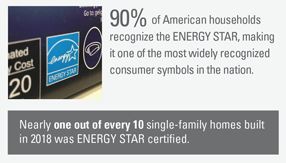On the Path to a Zero Energy Home: Appliances and Electronics


On average, your home’s appliances which include: clothes washers, dryers, dishwashers, refrigerators, freezers, air purifiers, etc., account for 20 percent of your home’s total electric bill. But all appliances aren’t created equal, some appliances use more energy than others. Most appliances sold in the U.S. are Energy Star certified. This means that they use less energy than their conventional, non-energy efficient counterparts. However, energy efficient appliances can come at a price premium. Are energy efficient appliances worth it?
Phantom Loads
Phantom load, also known as standby power or vampire power, is the electricity that any device consumes when it is turned off but still plugged into an outlet. These electronic devices provide the modern-day conveniences we rely on, but they also waste lots of energy and cost money. The U.S. Department of Energy says on average, 75 percent of the electricity used to power home electronics is consumed while the products are turned off.
When trying to eliminate your phantoms, you’ll get the biggest energy savings by going after the biggest abusers first. Here are a couple of the culprits:
DVRs/TiVos – DVRs and TiVos use 37 watts even when turned off. This equates to approximately 324 kilowatt-hours (kWh) and with an average energy cost of $29.17 a year for each DVR or TiVo device you own.
RELATED: What is a Blower Door Test?
Home offices – In most home offices you can find a computer, monitor, speakers, and a multi-function printer. All these devices combined can use up to 19 Watts a month. This means it costs almost $15 a year just to keep your equipment plugged in. The cost increases the more that the equipment is on and in use.
Appliances: Piece by Piece
 Induction Stove Tops – An induction cooktop heats 30% more efficiently than a gas range and about 12% more efficiently than an ordinary electric range. Induction cooktops also heat more quickly than regular electric ranges and significantly faster than gas ranges. Induction cooktops heat the molecules in the pan rather than heating the cooktop itself. When you are done cooking, the cooktop usually is warm, but not hot, so it is safe to touch and easy to clean. Gas stoves create indoor air pollution that often exceeds EPA limits for indoor air quality, making it best to avoid installing them in very airtight homes.
Induction Stove Tops – An induction cooktop heats 30% more efficiently than a gas range and about 12% more efficiently than an ordinary electric range. Induction cooktops also heat more quickly than regular electric ranges and significantly faster than gas ranges. Induction cooktops heat the molecules in the pan rather than heating the cooktop itself. When you are done cooking, the cooktop usually is warm, but not hot, so it is safe to touch and easy to clean. Gas stoves create indoor air pollution that often exceeds EPA limits for indoor air quality, making it best to avoid installing them in very airtight homes.
Microwave Ovens – Microwave ovens are significantly more energy efficient and faster than electric or gas ovens. Microwaves should be sized so they can be used for most cooking. Recipes and techniques for cooking a wide variety of foods in a microwave oven are readily available online.
High RPM Washer with Cold Water – A front-loading high RPM clothes washer with a 1400 RPM spin cycle and a fan fresh (fluff) option will take almost all of the moisture out of wet clothes without heat, minimizing the use of a dryer or time needed to line-dry laundry. All washers have energy-saving cycles that use only cold water. Since hot water heating uses more energy, it makes sense to recommend cold water washing to zero energy home buyers.
Clothes Dryers – Standard electric or gas dryers use a considerable amount of energy and must exhaust to the outside, creating the equivalent of a large (though intermittent) air leak in an otherwise super-tight building shell. Air drying clothes saves a lot of energy. Outdoor clothes lines and indoor drying racks are cost effective. In dry climates, indoor drying can bring welcome moisture to household air. In moister climates, outdoor clothes lines are a better option.
Heat Pump Dryers – If an automatic clothes dryer is needed, consider a heat pump condensing dryer. Using the same technology as refrigerators, space heating heat pumps, and water heating heat pumps, these dryers get more heat from each unit of electricity than a typical electric dryer, typically saving 50 to 60% on energy costs. Heat pump clothes dryers have been used in Europe for many years but are new to the U.S. market. The models currently available are more costly than standard dryers but may pay for themselves within about 5 years. In the future, as costs come down, they will be the electric dryer of choice.
Efficient Dishwashers – In selecting a dishwasher, look for those with an Energy Factor of 0.85 or greater. For example, the Bosch dishwasher is a highly energy efficient, water-saving dishwasher with an energy factor of about 1, however, it’s price tag may make it less cost effective than other, somewhat less efficient, Energy Star dishwashers.
Home Electronics – The biggest offenders in today’s energy efficient homes are big screen TVs, gaming consoles, computers, and other electronics. Most electronics are energy hogs and almost all electronics have large “phantom loads” wasting energy 24/7. Consider purchasing the most energy efficient electronics available, install manual on-off switches, and use power strips for electronics in order to reduce these phantom loads. Install electric outlets in rooms where electronics are likely to be used so they can be turned completely off with a wall switch. There are special switches available for turning off plug loads for entertainment centers without prolonging the start-up time.
What You Pay vs What You Save
There are the monthly energy savings that most people think of when they get an Energy Star/energy efficient appliance. But, what is the upfront cost? How much will have you have to spend to get those energy savings and is a premium worth it? Well, let’s first compare the prices of Energy Star appliances to non-certified appliances. You would think that Energy Star products cost more. But you would be surprised. Years ago that was the case. You would pay somewhere It used to be the case years ago that non-certified appliances could cost anywhere from $25 to $200 less than their Energy Star certified counterparts. That’s a lot of money just to hope the investment pays for itself.
Thanks to the high demand for Energy Star products over the past few years, manufacturers have developed more certified appliances than non-certified. This means the cost has decreased so much that Energy Star products no longer cost more than their counterparts in most cases. In some cases, they may even cost even less.
Size Matters (or Right-size When You Down-size)
Appliance size matters. When you downsize think about getting smaller appliances. As part of your zero energy strategy, consider selecting smaller appliances as well. For example, a 20-cubic-foot refrigerator uses less energy, square footage, and purchasing power than a 28-cubic-foot model. Consider downsizing the dishwasher from the standard 24-inch model to an 18-inch or a drawer-type dishwasher. It may not be convenient to downsize in all circumstances because appliance size will need to reflect the needs of the household.
Modular Homes and Energy Efficiency
Modular construction is a building system. By using a consistent system to build your home, details that are often overlooked in traditional construction are managed and done properly in a factory environment. Building a home to a high performance standard is almost a by-product of building indoors. You can reduce your energy costs by methodically reviewing your appliances and electronics to reduce your energy usage. Modular construction means factories methodically build your home to a defined standard. This standard means you are getting a home that was built to be more energy efficient than its site built counterpart. You get the benefit the being built better provides. Let modular put you on the path to zero energy bills.
The post On the Path to a Zero Energy Home: Appliances and Electronics appeared first on Impresa Modular.




